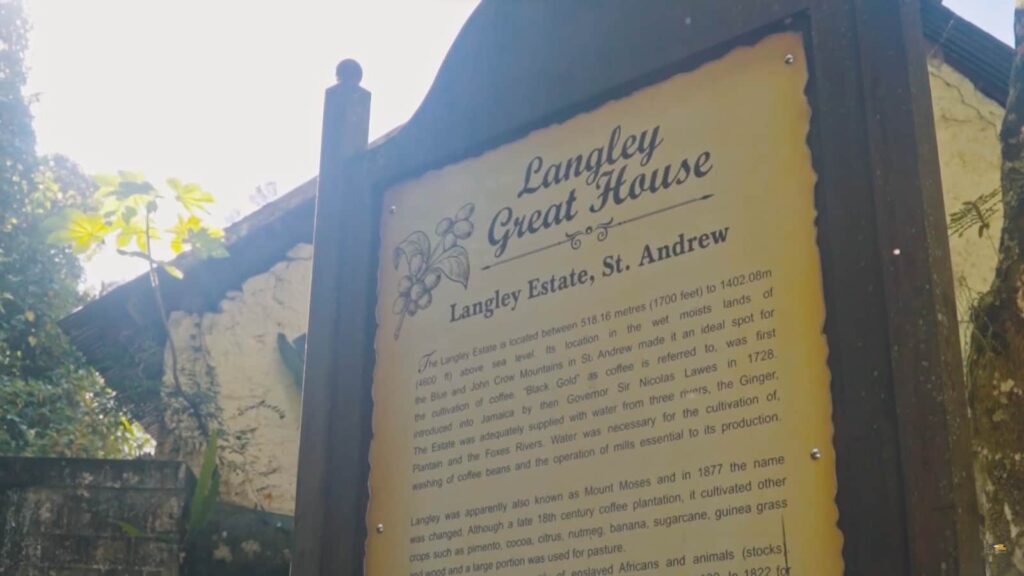Nestled beside the main road of Mount Airy in Mount James, the rural charm of St. Andrew envelops the Langley Estate. Presented with a three-day weekend and minimal information available online, explorers are often intrigued to seek out this elusive spot. Surprisingly, it reveals itself as an easily accessible treasure. This article seeks to ignite a new appreciation for the Langley Estate, advocating for its much-needed preservation and upkeep—a sentiment shared by those who cherish Jamaica’s historical sites. The narrative that follows retraces the steps to this hidden piece of heritage.
If you’re interested in the Langley Great House, you may also like our article on the therapeutic mineral baths of Jamaica.
Langley Great House: A Traveler’s Guide
Navigating with Google Maps in Jamaica can be unpredictable, and it certainly proved unreliable for locating Langley Great House. While the pin for the Great House on Google Maps is accurate, the map’s omission of most of the Mount Airy main road is baffling, to say the least. You might presume that reaching the house requires an arduous trek through dense underbrush based on the map, but thankfully, that’s not the reality.
The journey along Mount Airy is manageable, barring a few potholes, tight bends, and a segment allowing only one-way traffic. To begin, make a right at the Golden Spring Total gas station, then continue on the main road. At the divergence by a blue and white Supreme Ventures shop and a church, stick to the left path. Notable points along the route include the Mount James Post Office, the location of Street Food Saturdays, and several small shops. Some signs along the way to the Street Food Saturdays spot are also quite helpful, reassuring you that you’re en route. From Manor Park, the drive is about 30 minutes until you’re greeted by a striking signpost at the final turn.
You should park close to the aforementioned sign, from where it’s a leisurely five-minute walk downhill to the great house. Look for a large gate beside a sign marked “private property” on your left, and proceed through the gate—steering clear of the private grounds, of course. Along the way, admire the vibrant heliconias, bird of paradise flowers, and majestic trees, relics of bygone centuries. If only these trees could narrate their long history! And a little note: visits are complimentary, with no need to book ahead.
Discovering the Langley Great House & Its Rich Past

- Perched between 1700 and 4600 feet above sea level on what was once 999 acres, the Langley Great House, originally known as Mount Moses, adopted its current name in 1877;
- Its fertile grounds once produced a bounty of crops such as coffee, pimento, cocoa, citrus, nutmeg, banana, sugarcane, and also featured guinea grass, wood, and open pastures for grazing livestock;
- Situated in the verdant Blue & John Crow Mountains, the area boasts the distinction of being Jamaica’s first and only UNESCO World Heritage Site;
- Langley’s agriculture thrived with an ample water supply from the Ginger, Plantain, and Foxes Rivers. This water not only served domestic needs but also fueled the cultivation and processing of Blue Mountain coffee, powering two water wheels vital for milling and exporting the beans.
The history of Langley, like many estates in Jamaica, is marred by its reliance on slavery. In 1822, records show 229 enslaved Africans at Langley, listed as assets alongside livestock. Presently, the remnants of Langley include the Plantation House, a forsaken footbridge across the river, and patches of land that are still cultivated. The terrain, particularly during the rainy season, is dotted with waterfalls and natural pools. Sections of the estate are leased by the National Water Commission for water collection. The land, now spanning 845 acres, is under the stewardship of the Commissioner of Lands.
A visit to the great house includes an encounter with Basil, one of the caretakers, who shares intriguing historical facts and displays a deep passion for the area’s rejuvenation. He envisions transforming the site into an ecotourism and nutraceutical destination, given the current cultivation of plants like rosemary and castor beans, which have both beauty and medicinal benefits. The feasibility of these dreams is pending, awaiting the attention of a visionary investor. Meanwhile, local developments such as the addition of two gazebos by Juliet Cuthbert-Flynn, the Member of Parliament, hint at the potential for the estate to become a cherished recreational space.
The Waterways of Mount James

The journey continued with a visit to the nearby river, guided by insights from the caretaker. The path meandered past remnants of old water infrastructure, leading to a community-frequented pool. Given the dry season, the waters were calm and clear, inspiring a search for a more serene spot upstream, perfect for tranquil contemplation. A return trip during the rainy season is highly anticipated to experience the river’s full vitality. It’s advisable to come equipped with insect repellent, as the local mosquitoes are quite persistent, though not as troublesome as those found at Cunha Cunha Pass.
Conclusion
The Langley Great House presents an interesting dichotomy: the river may lack luster during the drier months, but the house stands as a remarkable structure. Imagining its potential with proper care and restoration stirs excitement, offering a stark contrast to sites like the Stewart Castle in Trelawny, which would require extensive reconstruction. The house, in its current state, holds a quiet promise waiting to be realized with just a touch of revival.